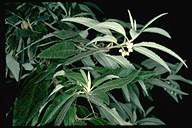

 |
Australian National Botanic Gardens
|
 |
A weekly news sheet prepared by a Gardens' volunteer.
Numbers in square brackets [] refer to garden bed Sections.
Plants in flower are in bold type.
25 June 2004
 |
|
Asterotrichion discolor
- click for larger image
|
Grevilleas are bursting into flower, banksias and correas are in flower and others, well, follow this walk and see for yourself. Crossing the bridge, the fragrant perfume is from Asterotrichion discolor [Section 66] with tiny white flowers amid the soft leaves on branches over this bridge. Along the Main Path, Banksia baueri [Section 30] is low and lovely with large woolly fawnish flower spikes.
Veering off the Main Path, taking a smaller path, Banksia spinulosa var. collina [Section 27] is of medium size bright with yellow flower spikes. There are numerous banksias and grevilleas amid the white trunks of Eucalyptus mannifera along this path. Then, cross the road see the rounded small shrubs of Correa ‘Candy Pink’ [Section 112] with pink bell star flowers. Take another small path through this section to see Correa ‘Gladys Cumpston’ [Section 112] with slim red flowers, green mouth and long green styles. It is a wide shrub of medium height. Across the path Banksia ericifolia var. ericifolia [Section 112] with bright gold upright flower spikes, looks across other shrubs. Wattle birds are enjoying its nectar while kookaburras are laughing about the glorious sunny day.
 |
|
Grevillea parallelinervis
- click for larger image
|
Cross the road take the path at the far side of the Sydney Region Flora Gully, a blackthorn, Bursaria spinosa var. spinosa [Section 191S] is a tall slim dark leaved thorny shrub crowned with clusters of tiny white flowers. A wattle, Acacia saliciformis [Section 191K] has a willowy habit with an abundance of soft cream flower balls. Epacris longiflora [Section 191F] has slim bright red flowers with white mouth along its low wiry branches, seen along this narrow path. Likewise Crowea exalata [Section 191K] shows its pale pink star flowers over a dense rounded shrub. Pass by the pink-grey trunk of the smooth barked apple, Angophora costata subsp. costata [Section 191F] to Correa lawrenciana var. macrocalyx [Section 191F] with yellow-green tubular flowers blending with the dense foliage. Acacia terminalis [Section 191F] in the centre of the bed, has cream fluffy flowers and bipinnate leaves. The Crowea saligna [Section 191F] shrubs are a picture. They have an abundance of brilliant pink star flowers covering the foliage. Close by Epacris pulchella [Section 191F] is another wiry plant with terminal tiny white flower clusters and Banksia oblongifolia [Section 191F] has a few upright branches exposing the attractive green flower spikes.
Return, crossing the gully to the road on the far side, turning downhill. Along this road, opposite the Eucalypt Lawn, Grevillea parallelinervis [191G], is a small shrub with pendulous red flowers with cream tips. Turning right at the next marked corner on the map, hakeas include Hakea orthorrhyncha var. filiformis [Section 21] with old bare woody branches covered with small red lacey flowers, tipped with long fine leaves. Hakea verrucosa [Section 21] is a small shrub pink with lacey flowers while Hakea cristata [Section 23] is a medium open shrub with branches lined with white flower balls – such attractive hakeas.
Returning to the Visitors Centre, the garden edging Banksia Walk contains Darwinia ‘Mondurup Bell’ [Section 174]. A small shrub laden with red pendular buds which will mature to lovely red bells – worth watching for.
Pleasant walking – many flowers … Barbara Daly.